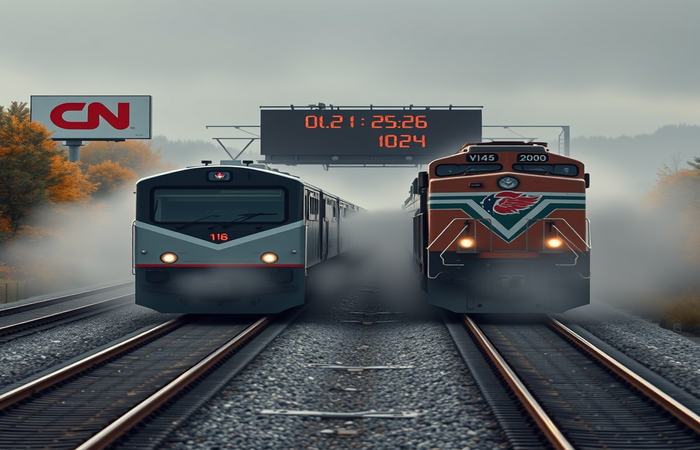VIA Rail OTP Plummets: Infrastructure Dispute Impacts Canada Rail
VIA Rail’s on-time performance plummeted to 30% in Q1 2025. Speed restrictions from CN, impacting the Quebec City-Windsor corridor, fuel a legal dispute over infrastructure and safety.

Here’s the rewritten news article:
VIA Rail’s On-Time Performance Plummets Amidst Infrastructure Disputes
The Canadian passenger rail operator, VIA Rail, is facing a significant crisis regarding its on-time performance (OTP). According to the recently released Q1 2025 financial report, the company’s OTP has plummeted to a mere 30% during the first quarter of 2025, a stark contrast to the 72% OTP achieved in the same period of 2024. This dramatic decline is primarily attributed to speed restrictions imposed by Canadian National Railway (CN) on VIA Rail trains operating within the critical Quebec City-Windsor corridor. The situation has escalated to the point where VIA Rail has initiated legal proceedings, intensifying the conflict between the two railway entities. This article will delve into the specifics of this ongoing dispute, analyzing the factors contributing to the OTP decline, the differing perspectives of VIA Rail and CN, and the potential ramifications for both passenger and freight rail services across Canada. The core issue revolves around infrastructure limitations, safety protocols, and the complex relationships within the Canadian railway landscape.
The Steep Decline in On-Time Performance
The most striking aspect of the Q1 2025 financial report is the severe reduction in VIA Rail’s OTP. The 30% figure indicates that only a fraction of the trains adhered to their scheduled arrival times, leading to substantial delays and disruptions for passengers. This marks a significant deterioration compared to the previous year’s performance, where a 72% OTP demonstrated a more reliable service. The Quebec City-Windsor corridor, a vital artery for VIA Rail’s passenger services, has been particularly affected by the CN-imposed speed restrictions. These restrictions, implemented due to concerns regarding infrastructure and train-to-signal interaction, have forced trains to operate at reduced speeds, extending journey times and impacting the overall punctuality of the service. The resulting delays have not only frustrated passengers but have also damaged VIA Rail’s reputation and ability to compete with other modes of transportation.
Conflicting Narratives: VIA Rail vs. Canadian National
The core of the issue lies in the conflicting narratives presented by VIA Rail and CN. VIA Rail, through its President and CEO, Mario Peloquin, has publicly attributed the OTP decline to arbitrary and unnecessary infrastructure restrictions imposed by CN. The company has actively challenged these restrictions in court, suggesting that they are not warranted and are negatively affecting passenger service. VIA Rail’s position implies that CN’s actions are disproportionate and aimed at hindering its operations.
Conversely, CN maintains that the restrictions are a necessary safety measure. According to a CN spokesperson, the speed limitations are a direct consequence of VIA Rail’s alleged failure to adequately address equipment shortcomings, particularly concerning train-to-signal interaction within the Venture fleet. CN emphasizes the importance of ensuring proper interaction to protect the safety of passengers, railway workers, and the public. CN’s stance suggests that VIA Rail is responsible for the situation by not implementing the necessary adjustments to its rolling stock. The dispute highlights a broader issue of responsibility and accountability between the two rail operators and underscores the complexities of operating passenger services on infrastructure primarily designed for freight transportation.
The Role of Infrastructure and Safety Protocols
The underlying issue is a combination of aging infrastructure, and the complex interplay of train operations and signalling systems. CN, as the infrastructure owner, is responsible for maintaining and upgrading the track and signalling infrastructure. The speed restrictions imposed by CN likely stem from concerns about the ability of VIA Rail’s trains to interact safely with the existing signalling systems, particularly at higher speeds. This situation indicates that the existing infrastructure may not be fully compatible with VIA Rail’s newer Venture fleet, which requires the company to address potential incompatibilities and the potential risks involved. If there are potential risks, this forces CN to act and restrict speed to protect passengers, employees, motorists and pedestrians.
Conclusion
The sharp decline in VIA Rail’s on-time performance during Q1 2025 is a serious concern, revealing operational challenges and deep-rooted tensions between VIA Rail and CN. The dispute is rooted in conflicting perspectives on safety, infrastructure management, and equipment compatibility. VIA Rail’s legal challenge and CN’s insistence on safety protocols point to a complex situation that requires a multi-faceted approach. The resolution of this conflict is crucial, not only for the recovery of VIA Rail’s OTP but also for the broader health and efficiency of Canada’s rail network. Resolving this dispute means establishing a clear and transparent communication, where both parties can address their differences with an agreement that ensures the safety of passengers, the efficiency of the rail system and respect of the infrastructure and equipment. Without a swift resolution, the current situation could persist, damaging the reputation of both companies and affecting the economic and social benefits of reliable passenger and freight rail services across Canada. The future of passenger rail service in the Quebec City-Windsor corridor, and potentially beyond, hinges on the ability of VIA Rail and CN to find common ground and prioritize the long-term sustainability and safety of the country’s railway system.
Summary about companies
VIA Rail Canada: is Canada’s national passenger rail service. It operates across Canada, with a focus on the Quebec City-Windsor corridor, providing intercity passenger rail services.
Canadian National Railway (CN): is a major Canadian freight railway. CN operates a vast network of tracks across Canada and the United States. In this case, CN owns and maintains the railway infrastructure used by VIA Rail.
Country: Canada
Date: October 26, 2024


